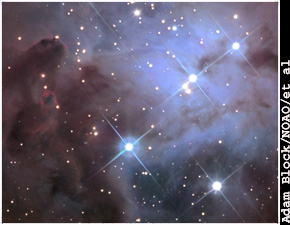Neptune is the eighth planet from the sun. It orbits at an average distance
of 2,794 million miles (30 times farther than Earth).
About 4 Earths would fit across the face of Neptune. Neptune is slightly
smaller than Uranus and has a diameter of 30,775 miles
It takes 165 Earth years for Neptune to go around the sun one time, but only
16 Earth hours for it to spin on its axis once.
The average temperature on Neptune is -370°F.
Neptune is encircled by a collection of 6 narrow rings. Because some places
have more particles than in others, Neptune's rings form arcs around the planet.
The atmosphere of Neptune holds hydrogen (79%), helium (18%), and methane
(3%). Methane gives Neptune its blue color.
Neptune's atmosphere has a striped pattern like Jupiter and Saturn. Neptune
once had a Great Dark Spot similar to Jupiter's Great Red Spot.
To escape Neptune's gravity you need to travel 52,600 miles per hour.
Johann Galle and Heinrich D'Arrest discovered Neptune in 1846.
Neptune has at least 8 moons. The two largest moons are Triton and Nereid.
Triton is made of rock and ice. Its surface is rich in water ice, dry ice, and frozen carbon monoxide, methane, and nitrogen.
Triton has cold geysers that spit nitrogen instead of the hot water that Earth geysers release.
Neptune was the Roman god of the oceans.

